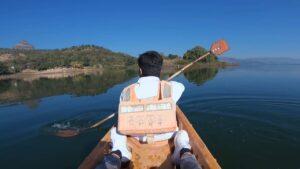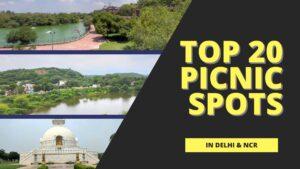Goa is a state that offers a diverse and delightful destination for travelers. It lies on the western coast of India, where it enjoys a long coastline with some of the country’s most beautiful and serene beaches. Goa also has a rich and varied cultural heritage that reflects its colonial history.
Portuguese ruled Goa for over four centuries and left a legacy of stunning architecture, cuisine, and festivals. Goa is a place where you can enjoy the natural beauty of the coast and the cultural charm of the Portuguese. We will guide you through Goa’s attractions, weather, festivals, and tips to help you plan your trip to this coastal paradise with a Portuguese legacy.

Best Time to Visit Goa
If you want to experience Goa’s pleasant weather, lively beaches, and festive events, you should plan your trip between November and February. This is the most popular time to visit Goa, so you will find many tourists, as well as higher prices and crowds.
Choose to go to Goa during the rainy season from June to September, which offers lower rates and less people, but also more rain and less beach activities. The summer season from March to May is not recommended, as it is too hot and humid to enjoy Go.
Beaches in Goa
Goa is a state in India that is known for its beautiful and diverse beaches. There are over 40 beaches in Goa, each with its own charm and attraction. Some of the famous beaches in Goa are:
Baga Beach: Baga Beach is one of the most popular and lively beaches in Goa, famous for its nightlife, beach parties, water sports, and seafood. It lies in North Goa, close to Calangute Beach.
- Baga Beach gets its name from the Baga Creek, which empties into the Arabian Sea at the north end of the beach.
- Baga Beach is a part of a long stretch of sand that starts from Sinquerim and Candolim in the south and ends at Anjuna and Vagator in the north.
- Baga Beach offers a variety of activities for tourists, such as parasailing, jet skiing, banana boat rides, dolphin spotting, etc. It also has many shacks, cafes, pubs, and clubs that offer live music, entertainment, and delicious food.
- Baga Beach is also known for its annual events, such as the Sunburn Festival, a three-day electronic dance music festival that attracts thousands of music lovers from around the world.
- Baga Beach is easily accessible by road from Mapusa, Panaji, or other nearby towns. There are also buses and taxis that make it easy to travel. There are many hotels, resorts, guest houses, and homestays near the beach that cater to different budgets and preferences.
Palolem Beach:
Palolem Beach is one of the most scenic and serene beaches in Goa, famous for its crescent-shaped coastline, palm trees, and colorful huts. It is located in South Goa, near Agonda Beach.
- Palolem Beach is situated in Canacona, a town in southern Goa that has a rich history and culture. Canacona was once part of the Kingdom of Sunda, which ruled over parts of Karnataka and Kerala.
- Palolem Beach offers a variety of activities for tourists, such as yoga, dolphin spotting, kayaking, hiking, etc. It also has many shacks, cafes, restaurants, and bars that offer live music, entertainment, and delicious food.
- Palolem Beach is known for its Silent Noise parties, where people dance to music played on wireless headphones. These parties are held every Saturday night at Neptune Point, a rocky headland at the northern end of the beach.
- Palolem Beach is also known for its beach huts, which are temporary structures made of bamboo and palm leaves that provide accommodation for tourists. These huts are available in different sizes, prices, and amenities, depending on the season and demand.
Vagator Beach:
Vagator Beach is one of the most picturesque and secluded beaches in Goa, famous for its red cliffs, white sand, and sunset views. In North Goa, it is close to Anjuna Beach.
- Vagator Beach is divided into two main beaches by a seaside cliff: Big Vagator or North Vagator and Little Vagator or Ozran Beach. There is also a smaller beach called Middle Vagator between them.
- Vagator Beach is known for its natural beauty and tranquility. It is less crowded and commercialized than other beaches in Goa. It attracts mainly backpackers, hippies, and nature lovers.
- Vagator Beach is also known for its historical and cultural attractions. It is close to the Chapora Fort, a 17th-century Portuguese fort that offers panoramic views of the Arabian Sea and the surrounding landscape.
- Vagator Beach offers a variety of activities for tourists, such as swimming, sunbathing, surfing, hiking, etc. It also has many shacks, cafes, restaurants, and bars that offer local and international cuisine, live music, entertainment, and nightlife.
Colva Beach:
Colva Beach is one of the longest and busiest beaches in Goa, famous for its silver sand, coconut groves, and colonial buildings. It is located in South Goa, near Margao.
- Colva Beach is part of a 25 km long stretch of sand that extends from Bogmalo in the north to Cabo de Rama in the south. It is one of the oldest and most popular beaches in Goa, attracting both domestic and international tourists.
- Colva Beach offers a variety of activities for tourists, such as swimming, sunbathing, water sports, shopping, etc. It also has many shacks, cafes, restaurants, and bars that offer local and international cuisine, live music, entertainment, and nightlife.
- Colva Beach is also known for its historical and cultural attractions. It is home to the Our Lady of Mercy Church, a 17th-century Portuguese church that hosts the annual Fama festival in October. It is also close to the Colva Residency, a heritage hotel that was once a summer retreat for the Portuguese governors.
- Colva Beach is easily accessible by road from Margao, Panaji, or other nearby towns. There are also buses and taxis that make it easy to travel.There are many hotels, resorts, guest houses, and homestays near the beach that cater to different budgets and preferences.
Arambol Beach:
Arambol Beach is one of the most peaceful and hippie beaches in Goa, famous for its natural beauty, bohemian vibe, and sweet water lake. It is located in North Goa, near Morjim Beach.
- Arambol Beach is also known as Harmal Beach, as it is situated in the village of Harmal. It is the northernmost beach in Goa and is about 50 km from Panaji.
- Arambol Beach offers a variety of activities for tourists, such as yoga, dolphin spotting, kayaking, hiking, etc. It also has many shacks, cafes, restaurants, and bars that offer local and international cuisine, live music, entertainment, and nightlife.
- Arambol Beach is known for its hippie culture and alternative lifestyle. It attracts many backpackers, artists, musicians, and spiritual seekers who come to enjoy the relaxed and friendly atmosphere of the beach. It also hosts many festivals and events, such as the Arambol Carnival, the Arambol Drum Circle, and the Arambol Paragliding Festival.
- Arambol Beach is also known for its sweet water lake, which is located at the northern end of the beach. The lake is surrounded by green hills and has medicinal properties. It is a popular spot for swimming, bathing, and mud therapy.
Architecture
Goa’s architecture reflects its colonial history, as well as its natural beauty. The state was under Portuguese rule for more than 400 years, starting from the early 16th century. Their legacy can be seen in the many churches, cathedrals, and old houses that are scattered across the state.
Basilica of Bom Jesus:
Goan cuisine is a result of the Portuguese influence. The combination of Indian spices and Portuguese flavors has given rise to a unique culinary tradition. Goan dishes like fish curry, vindaloo, and sorpotel showcase this blend of cultures and are a delight for food lovers.
Lively street markets and beach shacks serve a variety of tasty seafood and traditional Goan delicacies, allowing visitors to enjoy a culinary adventure. You can also taste some of the local drinks like feni, a liquor made from cashew or coconut sap, or sol kadi, a refreshing drink made from kokum fruit and coconut milk.
How to Travel in Goa?
Goa has a variety of public and private transportation options to choose from. You can take buses, taxis, auto-rickshaws, or taxi bikes to get around the state. You can also rent a car, a scooter, or a bicycle to explore Goa at your own pace. Another option is to take ferries that connect different islands and villages along the coast.
Do I need a visa to visit Goa?
Goa is a part of India, so you will need a valid visa to enter the country. You can apply for an e-visa online, which is valid for 60 days and allows double entry. You will need to upload your passport photo, passport scan, and pay the visa fee online. You will receive your e-visa by email, which you need to print and carry with you. Alternatively, you can apply for a regular tourist visa at the nearest Indian embassy or consulate.
What are the best festivals to experience in Goa?
Goa is known for its vibrant and diverse festivals that celebrate its culture, religion, and music. Some of the best festivals to experience in Goa are:
- Goa Carnival: A four-day extravaganza of music, dance, parades, and parties that takes place in February or March every year. It is a legacy of the Portuguese rule and showcases the colorful and lively spirit of Goa.
- Sunburn Festival: One of the biggest electronic dance music festivals in Asia that takes place in December every year. It features some of the world’s best DJs, artists, and performers who set the stage on fire with their electrifying beats and performances.
- Shigmo Festival: A spring festival that celebrates the harvest season and the arrival of new life. It takes place in March or April every year and involves folk dances, processions, floats, and rituals that showcase the rich culture and traditions of Goa.
- Christmas and New Year: Goa is one of the best places to celebrate Christmas and New Year in India, as it has a large Christian population and a festive atmosphere. You can enjoy midnight masses, carols, cakes, fireworks, parties, and more at various churches, hotels, clubs, and beaches in Goa.
What are the rules for drinking and drugs in Goa?
Goa has a relaxed and liberal attitude towards alcohol and nightlife, but there are some rules that you should follow to avoid trouble. Some of the rules are:
- Goa has a legal drinking age of 25 years. You may be asked to show your ID proof before buying or consuming alcohol.
- Drinking on the beaches or in public places is prohibited and punishable by law. You can only drink at licensed bars, restaurants, clubs, or hotels.
- Drugs are illegal in Goa and carry severe penalties, including imprisonment and deportation. Do not buy, sell, possess, or consume any drugs in Goa. Say ‘No’ to drugs and avoid any suspicious offers or invitations.
Conclusion:
Goa is a coastal paradise with a Portuguese legacy that attracts millions of tourists every year. It is a state that offers a diverse and delightful experience for travelers of all kinds. Whether you are looking for a relaxing getaway, an adventurous escapade , a cultural exploration, or a festive celebration.
Enjoy the scenic and serene beaches of Goa, where you can sunbathe, swim, or indulge in water sports. You can also visit the historic and majestic churches of Goa, where you can admire the Portuguese architecture and learn about the colonial past. You can also savor the delicious and spicy cuisine of Goa, where you can taste the fusion of Indian and European flavors. You can also join the vibrant and lively parties of Goa, where you can dance, drink, and have fun.
Visiting Goa also requires some caution and respect. You should be aware of the risks and rules of traveling to Goa and follow them to avoid any trouble. You should respect the culture and religion of Goa and dress appropriately when visiting the holy places. You should also avoid drinking on the beaches or in public places and say no to drugs. You should also keep your valuables safe and use reliable transportation options.
Goa is a destination that will leave you mesmerized and amazed. It is a destination that will make you happy and satisfied. It is a destination that will make you want to return again and again. Goa is a coastal paradise with a Portuguese legacy that you should not miss.
Also Read: Grand Canyon National Park: A Guide to One of the World’s Wonders







